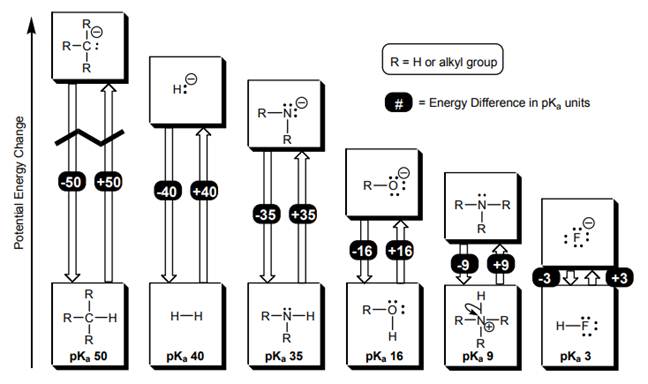
Concept explainers
Interpretation: Conjugate acid and conjugate base in each column of below table should be determined.

Concept introduction: According to the Bronsted-Lowry concept, a substance that donates proton is termed as acid while that accepts or gains protons is called a base. Species formed after loss of protons from acids are known as their respective conjugate bases whereas conjugate acid is produced by the addition of protons to base.
Conjugate acid of base is produced when hydrogen
Want to see the full answer?
Check out a sample textbook solution
Chapter 4 Solutions
Organic Chemistry: A Guided Inquiry
- The following are equivalent ways of asking about the acidity of an H atom: • What is the most acidic H on the molecule? • Which H is associated with the published pKa value? • Which H on the molecule is easiest to remove? • Which H on the molecule takes the least energy to remove? • Which bond to an H is most polarized? • For which H atom is removal least uphill in energy? • Which bond to an H atom, when broken, results in the lowest PE conjugate base? We will often find the last of these questions is easiest to answer. To do this, find all the different Hatoms on the molecule, and draw all possible conjugate bases.Only the lowest-energy one is the “real” conjugate base. Identify this structure, and you have found the most acidic H. Use this strategy to find the most acidic H on each of the following molecules. Note: Each structure hasat least three different kinds of H’s, so draw at least three unique conjugate bases for each.arrow_forwardFor each molecule below, draw the conjugate acid or conjugate base or both if the molecule hasboth a conjugate acid and a conjugate base (e.g., water).arrow_forwardConsider the following bases: a. For each base above, circle the atom/atoms with the highest PE (will release the most P.E.when a lone pair on this atom combines with an H+ ) b. Rank the bases 1 (highest P.E./strongest base) to 7 (lowest PE/weakest base), and explainyour reasoning.arrow_forward
- Complete the equation for the reaction between each Lewis acid-base pair. In each equation, label which starting material is the Lewis acid and which is the Lewis base; use curved arrows to show the flow of electrons in each reaction. In doing this problem, it is essential that you show valence electrons for all atoms participating in each reaction. (a) (b) (c) (d)arrow_forwardDraw the structure of the conjugate base of water. (Note that it does not appear in Figure 4.11).arrow_forwardFor the previous four questions, label each molecule that appears in the question or your answer asstrong acid, strong base, weak acid, or weak base.arrow_forward
- Construct an explanation for why sulfuric acid is such a strong acid. (Note that sulfur is in thethird row of the periodic table and can have more than eight electrons.)arrow_forwardAs we will see in later chapters, many steps in key reaction sequences involve acid–base reactions. (a) Draw curved arrows to illustrate the flow of electrons in steps [1]–[3]. (b) Identify the base and its conjugate acid in step [1]. (c) Identify the acid and its conjugate base in step [3].arrow_forwarda) Circle the weaker base in the following pairs. b) Explain your answers.arrow_forward
- Which do you expect to be the stronger acid: CH3CN or CH3NC? Explain. Hint: Draw out the complete Lewis structure for each molecule.arrow_forwardConsider cyclohexane and benzene (draw the structures below). Draw the conjugate base of each molecule and then explain why cyclohexane is the weaker acid.arrow_forwardWhy couldn't it be the H on the other side? Is it specific that only that one H can be the most acidic? Or does it not really matter because orienting the whole molecule such that we are looking at the opposite side of it, it is the same?arrow_forward
 Organic Chemistry: A Guided InquiryChemistryISBN:9780618974122Author:Andrei StraumanisPublisher:Cengage Learning
Organic Chemistry: A Guided InquiryChemistryISBN:9780618974122Author:Andrei StraumanisPublisher:Cengage Learning Organic ChemistryChemistryISBN:9781305580350Author:William H. Brown, Brent L. Iverson, Eric Anslyn, Christopher S. FootePublisher:Cengage Learning
Organic ChemistryChemistryISBN:9781305580350Author:William H. Brown, Brent L. Iverson, Eric Anslyn, Christopher S. FootePublisher:Cengage Learning

